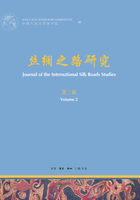
Four New Kharoṣṭhī Documents Kept in the Xinjiang Uygur Autonomous Region Museum
Fan Jingjing (Peking University)
Abstract: In this paper are presented four new Kharoṣṭhī documents kept in the Xinjiang Uygur Autonomous Region Museum. Two of them are legal transactions, respectively about custody rights over two sons and food loan dispute. The other two are a tax list and a payroll or account list. The peculiarity of the two lists is the new writing style of the numbers, presumably 1.5 and 2.
Keywords: Kharoṣṭhī, wooden tablet, Niya, divorce, tax
[*] 本文为段晴教授主持国家社科基金重大项目“新疆维吾尔自治区丝路南道所遗存非汉语文书释读与研究”(项目编号:12&ZD179)的阶段性研究成果之一。在写作过程中得到了段晴教授的悉心指点,相关问题经与姜一秀(现为莱顿大学在读博士生)深入讨论,颇受启发,特此致谢。此外,还要感谢新疆维吾尔自治区博物馆的工作人员授权研究释读这些木牍。
[1]矩形简牍往往是法律文书或官员间的往来信件。关于矩形简牍的形式特点与内容功用,参见Stein, M. Aurel, Ancient Khotan: Detailed Report of Archaeological Explorations in Xinjiang, Oxford, Clarendon Press, 1907, pp. 351-355,Duan Qing, “Deed, Coins and King's Title as Revealed in a Sanskrit Document on Cloth from the 6th Century”, Eurasian Studies, IV, 2016, pp. 182-195,以及关迪《古鄯善国佉卢文简牍的形制、功用与辨伪》,《西域研究》2016年第3期,第84—93页。
[2]本文所引文书编号(这里的No. 39与No. 45以及下文等),均指Boyer等Kharoṣṭhī Inscriptions Discovered by Sir Aurel Stein in Chinese Turkestan一书中的编号。Burrow在讨论音变时曾举例:元音间的k浊化,进一步变成ǵ,如avaǵaa=avakāśa等。参见Burrow, T., The Language of the Kharoṣṭhi Documents from Xinjiang. Cambridge, Cambridge UP, 1937, p. 6。
[3]佉卢文中对女性的各种称谓,参见Agrawala, Ratna Chandra, “Position of Women as Depicted in the Kharoṣṭhī Documents from Xinjiang”, The Indian Historical Quarterly 28, 1952, pp. 327-341。
[4]关于最后一行套话的详细语法分析,参见吴赟培《和田博物馆藏佉卢文尺牍放妻书再释译》,《西域研究》2016年第3期,第75—83页。
[5]段晴《元孟八年土地买卖楔印契约》,载段晴、张志清《中国国家图书馆藏西域文书——梵文、佉卢文卷》,上海:中西书局,2013年,第185—186页。
[6]段晴《酒、氍毹、毾㲪与罽》,载段晴、才洛太《青海藏医药文化博物馆藏佉卢文尺牍》,上海:中西书局,2016年,第54—57页。
[7]林梅村《新疆尼雅发现的佉卢文契约考释》,《考古学报》1989年第1期,第132页。
[8]Atwood, Christopher, “Life in Third-fourth Century Cadh'ota: A Survey of Information Gathered from the Prakrit Documents Found North of Minfeng (Niya)”, Central Asiatic Journal, 35, 1991, p. 169. 以及林梅村《犍陀罗语文书地理考》,《传统文化与现代化》1997年第6期,第33页。
[9]林梅村《新疆佉卢文文书释地》,《西北民族研究》1989年第1期,第73—76页。
[10]Burrow, T., A Translation of the Kharoṣṭhī Documents from Xinjiang, London, The Royal Asiatic Soceity, 1940, p. 26. 以及Atwood, Christopher, “Life in Third-fourth Century Cadh'ota: A Survey of Information Gathered from the prakrit Documents Found North of Minfeng (Niya)”, Central Asiatic Journal, 35, 1991, p. 187。
[11]同类型的账目文书在N. xv.遗址出土了一大批,参见Stein, M. Aurel, 1907, pp. 357-358。
[12]参见林梅村《沙海古卷》,北京:文物出版社,1998年,第155页。
[13]对daśavita的讨论,参见Stein, O., “The Numerals in the Niya Inscriptions”, Bulletin of the School of Oriental Studies, Vol. 8, No. 2/3, 1936, pp. 766-773。并参见林梅村《犍陀罗语文书地理考》,第33页。
[14]Padwa, Mariner Ezra. An Archaic Fabric: Culture and Landscape in an Early Inner Asian Oasis (3rd-4th Century C.E. Niya), Ph.D. diss., Harvard University, 2007, pp. 85-89.
[15]Thomas, F. W., “Some Notes on the Kharoṣṭhī Documents from Xinjiang”, Acta Orientalia, 13, 1935, pp. 56-57.
[16]Agrawala, Ratna Chandra, “A Study of Weights and Measures as Depicted in the Kharoshṭhī Documents from Xinjiang”, The Journal of the Bihar Research Society 38, 1952, p. 363.
[17]Boyer, A. M., E. J. Rapson, E. Senart, and P. S. Noble, Kharoṣṭhī Inscriptions Discovered by Sir Aurel Stein in Xinjiang, Oxford, Clarendon Press, 1920-1929, repr. in New Delhi, Cosmo Publications, 1997, pp. 321-322. 并参见Glass, Andrew, A Preliminary Study of Kharoṣṭhī Manuscript Paleography, MA Thesis, University of Washington, 2000, p. 139。
[18]这一推测是姜一秀在课堂讨论时提出,特此致谢。
[19]Glass, Andrew, A Preliminary Study of Kharoṣṭhī Manuscript Paleography, pp. 139-140.